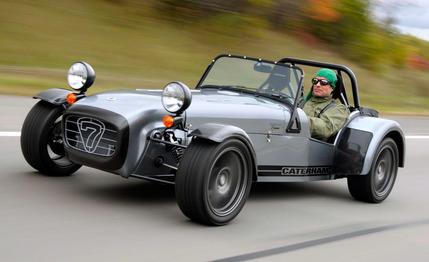
 Specialty File
Specialty File
In 1516, German authorities adopted the Reinheitsgebot, a.k.a. the German beer purity law, which rigidly defined the ingredients to be found in beer. A few centuries passed before an invention called the automobile appeared, and then in 1957, a company called Lotus introduced a model efficiently dubbed the 7. At that moment, the British seemed to have enacted an automotive purity law, as the 7’s creator, Colin Chapman, had engineered the ultimate basic but entertaining four-wheeled vehicle from a few simple ingredients (a tube-frame structure wrapped in aluminum, two seats, tiny dimensions, a four-cylinder engine). Most of all, the 7’s true nature is defined by what it lacks. It’s a car without power steering, doors, windows, bumpers, airbags, air conditioning, or a radio. Consequently, it is light, quick, and track ready. Driving one on the road is as liberating as skinny-dipping.
In the early 1970s, Chapman sold the recipe and rights to build the 7 to Caterham Cars, which has continued to brew and develop the 7 to rigid standards. Today, versions of the 7 range from the relatively relaxed, traditional Classic model with a solid axle and a bench seat to the carbon-fiber-laden 263-hp Superlight R500.
Caterham’s U.S. distributor (Caterham USA) sent us the penultimate version, the 210-hp Superlight R400, which is marginally heavier and only slightly less of a disguised race car than the top-dog R500 (“marginally heavier” in the case of the R400 works out to a still very light 1240 pounds). If weight is the enemy of performance, then the R400 just checked into a by-the-hour motel with performance. Acceleration to 60 mph takes only 3.7 seconds, a couple of ticks off a Porsche 911 Turbo. Handling responses and 1.04 g of grip are race-car-like. The unassisted brakes might feel a bit soft underfoot, but the Caterham stopped from 70 mph in 145 feet—only four more feet than our best-ever stopper, the Chevy Corvette ZR1.
All of the performance has a price beyond the shocker of the R400’s as-tested sticker, $57,603. Caterhams are unrefined, difficult to get in and out of, and deafening to ride in; they’ll make you smell like a hot engine, restyle your hair, and are highly impractical. Purists look past these minor flaws because of an exaggerated lust for performance. But take away the already slim seat padding, make the chassis even firmer, and broom the heater—as Caterham does in the Superlight R400 series—and the relationship turns abusive. The R400 is so obsessed with performance that the driver is left feeling like the jilted one in a love triangle.
Driven slowly, the R400 comes off as too extreme and unrefined to be enjoyed on the road for any length of time. Watching the front wheels leap over expansion joints is amusing at first, but the joke gets tiresome quickly. And just as skinny-dipping at a public pool will get you arrested, driving the R400 like a race car on public roads could result in a trip to a cold-water cell.
Eliminate too many ingredients from the Reinheitsgebot, and you’re left with water. Do the same to a Caterham, and it becomes a race car. Race cars are fun on racetracks. Less performance-oriented Caterhams such as the Roadsport 7 are more fun on the road than the race-car-like R400.
Caterham USA, 1212 West Custer Place, Denver, Colorado 80223; 303-765-0247; www.uscaterham.com